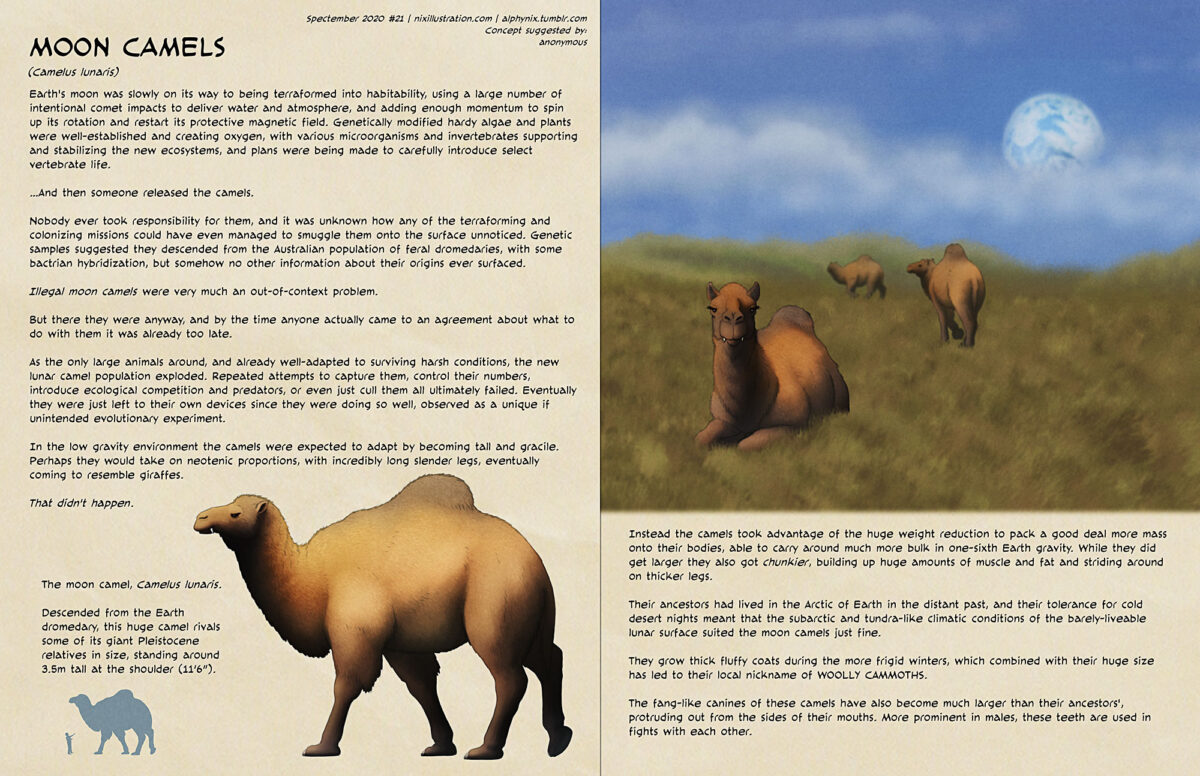Transcript for the text on the image under the cut:
PAGE 1
Spectember 2020 #21 | nixillustration.com | alphynix.tumblr.com
Concept suggested by:
anonymous
Moon Camels
(Camelus lunaris)
Earth’s moon was slowly on its way to being terraformed into habitability, using a large number of intentional comet impacts to deliver water and atmosphere, and adding enough momentum to spin up its rotation and restart its protective magnetic field. Genetically modified hardy algae and plants were well-established and creating oxygen, with various microorganisms and invertebrates supporting and stabilizing the new ecosystems, and plans were being made to carefully introduce select vertebrate life.
…And then someone released the camels.
Nobody ever took responsibility for them, and it was unknown how any of the terraforming and colonizing missions could have even managed to smuggle them onto the surface unnoticed. Genetic samples suggested they descended from the Australian population of feral dromedaries, with some bactrian hybridization, but somehow no other information about their origins ever surfaced.
Illegal moon camels were very much an out-of-context problem.
But there they were anyway, and by the time anyone actually came to an agreement about what to do with them it was already too late.
As the only large animals around, and already well-adapted to surviving harsh conditions, the new lunar camel population exploded. Repeated attempts to capture them, control their numbers, introduce ecological competition and predators, or even just cull them all ultimately failed. Eventually they were just left to their own devices since they were doing so well, observed as a unique if unintended evolutionary experiment.
In the low gravity environment the camels were expected to adapt by becoming tall and gracile. Perhaps they would take on neotenic proportions, with incredibly long slender legs, eventually coming to resemble giraffes.
That didn’t happen.
[Image: a dromedary camel with thick legs, a very chunky body, a thick coat of fur, and tusk-like fangs protruding from the sides of its mouth. A size comparison shows it stands around twice the height of a human.]
The moon camel, Camelus lunaris.
Descended from the Earth dromedary, this huge camel rivals some of its giant Pleistocene relatives in size, standing around 3.5m tall at the shoulder (11’6”).
PAGE 2
[Image: several camels in a lunar landscape covered in tundra-like vegetation, with the Earth visible in the blue cloudy sky above.]
Instead the camels took advantage of the huge weight reduction to pack a good deal more mass onto their bodies, able to carry around much more bulk in one-sixth Earth gravity. While they did get larger they also got chunkier, building up huge amounts of muscle and fat and striding around on thicker legs.
Their ancestors had lived in the Arctic of Earth in the distant past, and their tolerance for cold desert nights meant that the subarctic and tundra-like climatic conditions of the barely-liveable lunar surface suited the moon camels just fine.
They grow thick fluffy coats during the more frigid winters, which combined with their huge size has led to their local nickname of WOOLLY CAMMOTHS.
The fang-like canines of these camels have also become much larger than their ancestors’, protruding out from the sides of their mouths. More prominent in males, these teeth are used in fights with each other.

